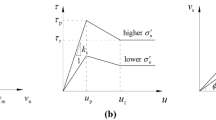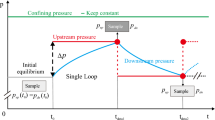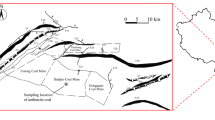Abstract
Coalbeds are subject to diverse load conditions stemming from hydraulic fracturing, mining activities, and geological tectonic forces. Understanding how coalbed permeability evolves under various stress conditions—such as effective stress, peak stress, axial deviatoric stress, and stress cycling—is crucial for optimizing coalbed methane flow dynamics. In this study, coal sample permeability evolution was assessed using the steady-state method under various loading paths. The study revealed insights into the impact of irreversible deformation induced by different axial deviatoric stresses on coal permeability. Our results indicate that confining pressure has a greater impact on axial permeability than axial stress does. Initial stress cycles involving confining pressure notably reduce coal permeability, an effect that is less pronounced in subsequent cycles. Different levels of axial deviatoric stress have varied consequences for coal fractures. Specifically, high axial deviatoric stress conditions promote fracture propagation, thereby enhancing coal seam permeability. Conversely, under low axial deviatoric stress, the cyclical application of axial and confining pressures results in coal compaction and fracture closure, leading to a decrease in permeability after unloading. To visualize microcrack development and propagation in coal under differing axial deviatoric stress conditions, we integrated the discrete element method with the Mohr–Coulomb model in a particle flow program. The findings from our triaxial seepage experiments corroborate well with this computational model, providing a robust validation and deeper insight into the observed permeability changes.

















Similar content being viewed by others
Notes
* 1 mD = 9.869233 10−16 m2
References
Behnoudfar, P., Asadi, M. B., Gholilou, A., & Zendehboudi, S. (2019). A new model to conduct hydraulic fracture design in coalbed methane reservoirs by incorporating stress variations. Journal of Petroleum Science and Engineering, 174, 1208–1222.
Carey, J. W., & Frash, L. (2016). Experimental study of fracture generation and permeability evolution during injection-induced precipitation in carbonate-rich shale.
Choo, J. (2018). Mohr-coulomb plasticity for sands incorporating density effects without parameter calibration. International Journal for Numerical and Analytical Methods in Geomechanics, 42(18), 2193–2206.
Chu, Y., Wang, M., Song, S., Zhang, J., Zhang, D., & Liu, F. (2022). Experimental study on the mechanical properties, permeability characteristics, and energy evolution of gas-containing anthracite coal under different loading-unloading speeds. Physics of Fluids, 34(12), 126608.
Ding, K., Wang, L., Wang, W., Li, Z., Jiang, C., Ren, B., & Wang, S. (2022). Experimental study on gas seepage characteristics of axially unloaded coal under different confining pressures and gas pressures. Processes, 10(6), 1055.
Duan, M., Jiang, C., Yin, W., Yang, K., Li, J., & Liu, Q. (2021). Experimental study on mechanical and damage characteristics of coal under true triaxial cyclic disturbance. Engineering Geology, 295, 106445.
Fan, L., & Liu, S. (2019). Evaluation of permeability damage for stressed coal with cyclic loading: an experimental study. International Journal of Coal Geology, 295, 103338.
Feng, K., Wang, K., & Yang, Y. (2021). Experimental study on the deformation and permeability characteristics of raw coal under the coupling effect of confining pressure and pore pressure. Advances in Materials Science and Engineering, 2021, 1–8.
Feng, R. M., Chen, S. N., Bryant, S., & Liu, J. (2019). Stress-dependent permeability measurement techniques for unconventional gas reservoirs: review, evaluation, and application. Fuel, 256, 15987. https://doi.org/10.1016/j.fuel.2019.115987
Fu, J., Li, B., Ren, C., Li, J., Wang, Z., Wu, X., & Jia, L. (2022). Coupling between damage evolution and permeability model with the adsorption effect for coal under gas extraction and coal mining conditions. Energy & Fuels, 36(18), 10813–10831.
Garvey, R., & Ozbay, U. (2011). Computer aided calibration of pfc3d coal samples using a genetic algorithm. In: Proceedings of the 2nd International Flac/Dem Symposium, Melbourne 14-16 February 2011: 493-499
Han, B., Xie, S. Y., & Shao, J. F. (2016). Experimental investigation on mechanical behavior and permeability evolution of a porous limestone under compression. Rock Mechanics and Rock Engineering, 49(9), 3425–3435.
Hao, X., Yuan, L., Wang, F., Zhao, Y., Lu, Z., & Ren, B. (2017). Analysis of failure of coal under tri-axial compression and inversion of its shear strength parameters. Journal of China University of Mining and Technology, 46(04), 730–738.
He, P., Kulatilake, P. H. S. W., Yang, X., Liu, D., & He, M. (2018). Detailed comparison of nine intact rock failure criteria using polyaxial intact coal strength data obtained through pfc3d simulations. Acta Geotechnica, 13(2), 419–445.
Huang, B., & Liu, J. (2013). The effect of loading rate on the behavior of samples composed of coal and rock. International Journal of Rock Mechanics and Mining Sciences, 61, 23–30.
Huang, K., Wu, J., Zhai, X., & Bi, Y. (2021). Tensile strength test of coal and rock with different coal structure. Industry and Mine Automation, 47(07), 115–119.
Huang, M., Zhang, L., Zhang, C., & Chen, S. (2019). Characteristics of permeability changes in bituminous coal under conditions of stress variation due to repeated mining activities. Natural Resources Research, 29(3), 1687–1704.
Huang, S., Xia, K., & Dai, F. (2012). Establishment of a dynamic mohr-coulomb failure criterion for rocks. International Journal of Nonlinear Sciences and Numerical Simulation, 13(1), 55–60.
Jia, H., Wang, K., Xu, C., & Fu, Q. (2022). Permeability distribution characteristics of underlying coal seam disturbed by mining activity. Energy Sources Part a-Recovery Utilization and Environmental Effects, 44(2), 5032–5047.
Kan, Z., Zhang, L., Li, M., Yuan, X., & Huang, M. (2021). Investigation of seepage law in broken coal and rock mass under different loading and unloading cycles. Geofluids, 2021, 1–14.
Le Gal, N., Lagneau, V., & Charmoille, A. (2012). Experimental characterization of ch4 release from coal at high hydrostatic pressure. International Journal of Coal Geology, 96–97, 82–92.
Li, H., Lau, H. C., & Huang, S. (2018). China’s coalbed methane development: a review of the challenges and opportunities in subsurface and surface engineering. Journal of Petroleum Science and Engineering, 166, 621–635. https://doi.org/10.1016/j.petrol.2018.03.047
Li, Q., & Xing, H. (2016). A new method for determining the equivalent permeability of a cleat dominated coal sample. Journal of Natural Gas Science and Eegineering, 34, 280–290.
Li, T., Chen, G., & Li, Q. (2022). Experimental study on rock-coal-rock composite structure with different crack characteristics. Geomechanics and Engineering, 29(4), 377–390.
Li, Z., & Rao, Q. (2021). Quantitative determination of pfc3d microscopic parameters. Journal of Central South University, 28(3), 911–925.
Lin, M., Lin, B., Yang, W., Zhao, Y., & Wang, Z. (2022). In-situ testing method of the permeability coefficient in a coal seam based on the finite volume method and its application. Journal of Natural Gas Science and Eegineering, 97, 104370.
Liu, Q., Li, Z., Wang, E., Niu, Y., & Kong, X. (2020). A dual-permeability model for coal under tri-axial boundary conditions. Journal of Natural Gas Science and Engineering, 82, 103524.
Liu, Z., Zhong, X., Qin, B., Ren, H., & Gao, A. (2019). Redevelopment of fractures and permeability changes after multi-seam mining of shallow closely spaced coal seams. Archives of Mining Sciences, 64(4), 16.
Lu, S., Li, M., Ma, Y., Wang, S., & Zhao, W. (2022). Permeability changes in mining-damaged coal: a review of mathematical models. Journal of Natural Gas Science and Engineering, 106, 104739. https://doi.org/10.1016/j.jngse.2022.104739
Meng, Z., & Li, G. (2013). Experimental research on the permeability of high-rank coal under a varying stress and its influencing factors. Engineering Geology, 162, 108–117.
O’Sullivan, C. (2011). Particle-based discrete element modeling: geomechanics perspective. International Journal of Geomechanics, 11(6), 449–464.
Potyondy, D. O. (2015). The bonded-particle model as a tool for rock mechanics research and application: Current trends and future directions. Geosystem Engineering, 18(1), 1–28.
Saurabh, S., & Harpalani, S. (2019). Anisotropy of coal at various scales and its variation with sorption. International Journal of Coal Geology, 201, 14–25.
Singh, A., Rao, K. S., & Ayothiraman, A. (2019). Study on mohr-coulomb-based three-dimensional strength criteria and its application in the stability analysis of vertical borehole. Arabian Journal of Geosciences, 12(18), 1–18.
Song, D., Wang, E., & Liu, J. (2012). Relationship between emr and dissipated energy of coal rock mass during cyclic loading process. Safety Science, 50(4), 751–760.
Song, J., Wang, H., Zhang, C., & Chen, S. (2023). Effects of crack properties on coal strength and failure mode: A simulation study. Rock Mechanics and Rock Engineering, 20, 1–23.
Stavropoulou, M., Liolios, P., & Exadaktylos, G. (2012). Calibration of the triaxial hyperbolic mohr-coulomb elastoplastic model parameters on laboratory rock mechanics tests. International Journal of Geomechanics, 12(6), 618–631. https://doi.org/10.1061/(ASCE)GM.1943-5622.0000182
Su, Z., Jing, S., Xie, W., & Tang, Q. (2022). Research on coal acoustic emission characteristics and damage evolution during cyclic loading. Frontiers in Earth Science, 10, 818452.
Tang, J., Yang, S., Yang, K., Tian, W., Liu, G., & Duan, M. (2023). Discrete element modeling of thermally damaged sandstone containing two pre-existing flaws at high confining pressure. Sustainability, 15(7), 6318.
Wang, D., Wei, J., & Yin, G. (2012). Investigation on change rule of permeability of coal containing gas under complex stress paths. Chinese Journal of Rock Mechanics and Engineering, 31(02), 303–310.
Wang, G., Yang, X., Chu, X., Shen, J., & Jiang, C. (2018). Microscale numerical simulation of non-darcy flow of coalbed methane. Arabian Journal for Science and Engineering, 43(5), 2547–2561.
Wang, H., Cheng, Y., & Yuan, L. (2013a). Gas outburst disasters and the mining technology of key protective seam in coal seam group in the huainan coalfield. Natural Hazards, 67(2), 763–782.
Wang, J. G., Liu, J., & Kabir, A. (2013b). Combined effects of directional compaction, non-darcy flow and anisotropic swelling on coal seam gas extraction. International Journal of Coal Geology, 109, 1–14.
Wang, Z., Li, B., Ren, C., Xu, J., Gao, Z., & Zhang, Y. (2022). A permeability model for coal based on elastic and plastic deformation conditions under the interaction of hydro-mechanical effects. Journal of Petroleum Science and Engineering, 212, 110209.
Woo, S. I., Seo, H., & Kim, J. (2017). Critical-state-based mohr-coulomb plasticity model for sands. Computers and Geotechnics, 92, 179–185.
Wu, Y., Zhang, Z., Wang, X., Zhu, P., Yang, X., Jiang, L., & Song, Z. (2021). Study on the physical properties and joint evolution characteristics of three-dimensional reconstructed coal. Advances in Materials Science and Engineering, 2021, 7038110.
Xu, C., Yang, G., Wang, K., & Fu, Q. (2021). Uneven stress and permeability variation of mining-disturbed coal seam for targeted cbm drainage: a case study in baode coal mine, eastern ordos basin, china. Fuel, 289, 119911.
Xue, Y., Gao, F., Gao, Y., Cheng, H., Liu, Y., Hou, P., & Teng, T. (2016). Quantitative evaluation of stress-relief and permeability-increasing effects of overlying coal seams for coal mine methane drainage in wulan coal mine. Journal of Natural Gas Science and Engineering, 32, 122–137.
Zhang, C., Zhang, L., & Wang, W. (2019). The axial and radial permeability testing of coal under cyclic loading and unloading. Arabian Journal of Geosciences, 12(11), 1–19.
Zhang, L., Huang, M., Xue, J., Li, M., & Li, J. (2021). Repetitive mining stress and pore pressure effects on permeability and pore pressure sensitivity of bituminous coal. Natural Resources Research, 30(6), 4457–4476.
Zhang, M., Shimada, H., Sasaoka, T., & Matsui, K. (2013). Lateral stress concentration in localized interlayer rock stratum and the impact on deep multi-seam coal mining. International Journal of Geosciences, 04, 1248–1255.
Zhang, P., Meng, Z., Zhang, K., & Jiang, S. (2020). Impact of coal ranks and confining pressures on coal strength, permeability, and acoustic emission. International Journal of Geomechanics, 20(8), 04020135.
Zhang, R., Cheng, Y., Zhou, H., Yuan, L., Li, W., Liu, Q., Jin, K., & Tu, Q. (2018). New insights into the permeability-increasing area of overlying coal seams disturbed by the mining of coal. Journal of Natural Gas Science and Engineering, 49, 352–364.
Zhang, Y. H., Xu, X. M., Lebedev, M., Sarmadivaleh, M., Barifcani, A., & Iglauer, S. (2016). Multi-scale x-ray computed tomography analysis of coal microstructure and permeability changes as a function of effective stress. International Journal of Coal Geology, 165, 149–156. https://doi.org/10.1016/j.coal.2016.08.016
Zhao, Y., Konietzky, H., Frühwirt, T., & Zhou, H. W. (2022). Gas permeability evolution of coal with inclusions under triaxial compression-lab testing and numerical simulations. Materials, 15(23), 8567.
Zhou, F., Xia, T., Wang, X., Zhang, Y., Sun, Y., & Liu, J. (2016). Recent developments in coal mine methane extraction and utilization in china: a review. Journal of Natural Gas Science and Engineering, 31, 437–458. https://doi.org/10.1016/j.jngse.2016.03.027
Zou, J., Chen, W., Yang, D., Yu, H., & Yuan, J. (2016). The impact of effective stress and gas slippage on coal permeability under cyclic loading. Journal of Natural Gas Science and Engineering, 31, 236–248.
Acknowledgments
This research is supported by the Zhejiang Provincial Natural Science Foundation of China (LY23E040001), Zhejiang Provincial Fundamental Research Funding Project (Category A, 2022YW06), and National Natural Science Foundation of China (51804287). These supports are gratefully acknowledged and appreciated.
Author information
Authors and Affiliations
Corresponding authors
Ethics declarations
Conflict of Interest
The authors declare that they have no known competing financial interests or personal relationships that could have appeared to influence the work reported in this paper.
Rights and permissions
Springer Nature or its licensor (e.g. a society or other partner) holds exclusive rights to this article under a publishing agreement with the author(s) or other rightsholder(s); author self-archiving of the accepted manuscript version of this article is solely governed by the terms of such publishing agreement and applicable law.
About this article
Cite this article
Liu, J., Xu, X., Zhang, Y. et al. Understanding the Irreversible Evolution of Coal Permeability Under Cyclic Axial Deviatoric Stress. Nat Resour Res 33, 887–905 (2024). https://doi.org/10.1007/s11053-024-10318-4
Received:
Accepted:
Published:
Issue Date:
DOI: https://doi.org/10.1007/s11053-024-10318-4




